Long live Lacroix: an ode to decadent style
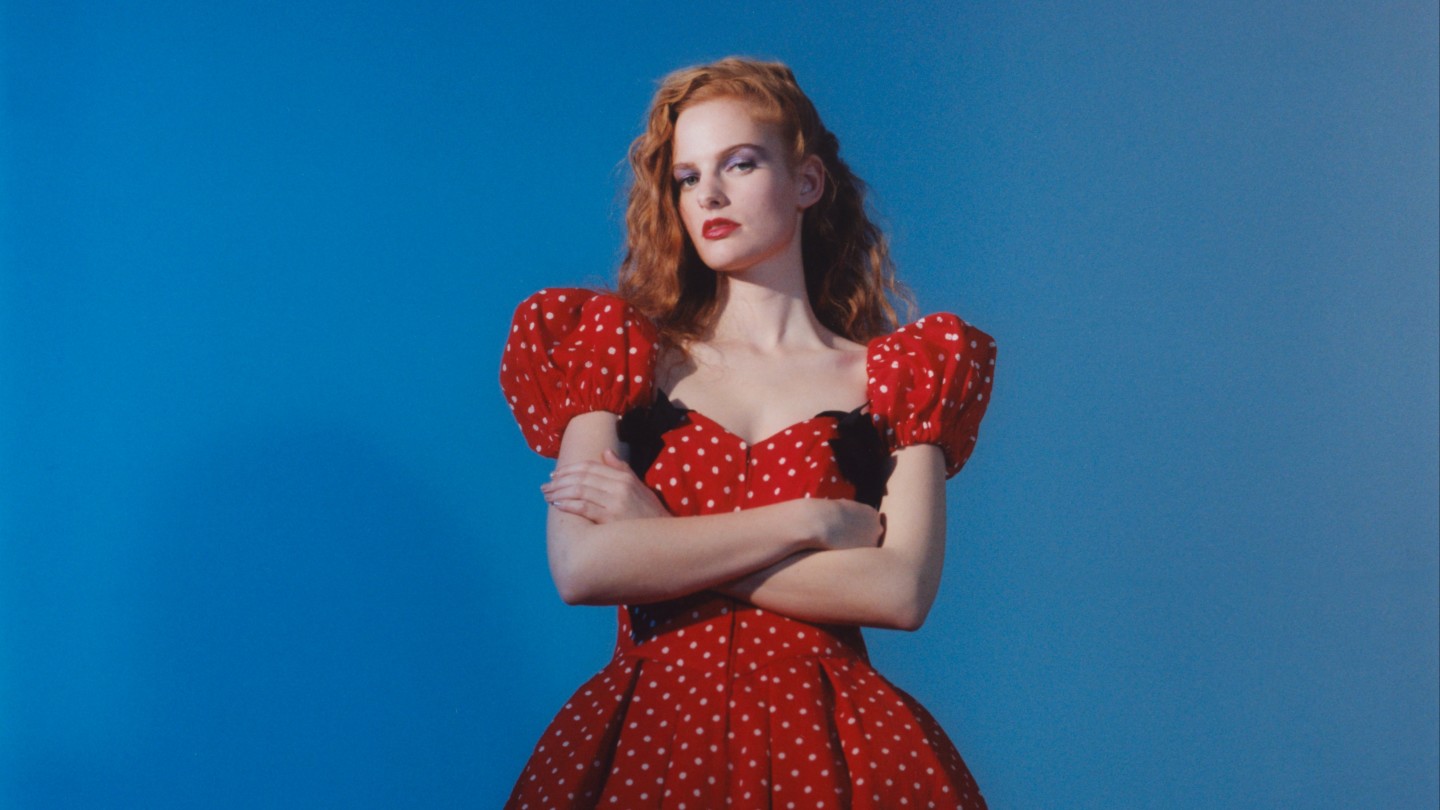
Simply sign up to the Fashion myFT Digest -- delivered directly to your inbox.
The ghost of Christian Lacroix rode high in the spring/summer 2020 collections: a new decade with an old mood. That mood is of exuberance, of extravagance, wilful, maybe even woeful, of pouffed volumes, lustrous fabrics and unholy colour combinations: cyclamen and turmeric yellow, chartreuse, blood orange and dead black evocative of the bullring, of the Caribbean and of the sleepy, history-steeped town of Arles where Christian Marie Marc Lacroix was born in 1951.
Ghost is perhaps the wrong term – Monsieur Lacroix is very much alive, still creating costumes, which were always his first love. He initially dreamt of being a museum curator, but instead became a curator in the truly postmodern, fashionable sense of the word, telescoping costume and cultural references and clashing them together in outfits that spoke of the past, and the present.
Presciently, they also spoke of the future. Today, there is a resurgence of Lacroix in fashion, in his use of colour, of decoration, of the historio- and ethnographic reference points he loved. Rick Owens, whose styles are usually executed in a Henry Fordian all-black palette and to whom the epithet “gothic” is frequently applied, created dresses for s/s 2020 with beetle-wing iridescence in frosted pink, apricot and sequin-smothered yellow with pouffed volume about the hips. Rei Kawakubo – another champion of black, whose hole-pocked Comme des Garçons clothes offered the antithesis of Lacroix’s hedgefund couture to earnest art dealers in the 1980s – showed a collection the same season devoted to operatic extremes. Her flowers and ruffles and bulbous coats in velvet, hung with passementerie fringe, were modern-day reflections of Lacroix’s love for intricate detail. The house of Patou, which Lacroix resurrected in the ’80s and which lay dormant since his resignation in 1987, has been revived under designer Guillaume Henry, who is using Lacroix’s coquettish imprimatur as the benchmark for the brand. And for several years, Pierpaolo Piccioli and Marc Jacobs have been drenching dresses with flowers and feathers and rich, saturated colour in homage to, if not outright emulation of, Lacroix’s distinctive style.
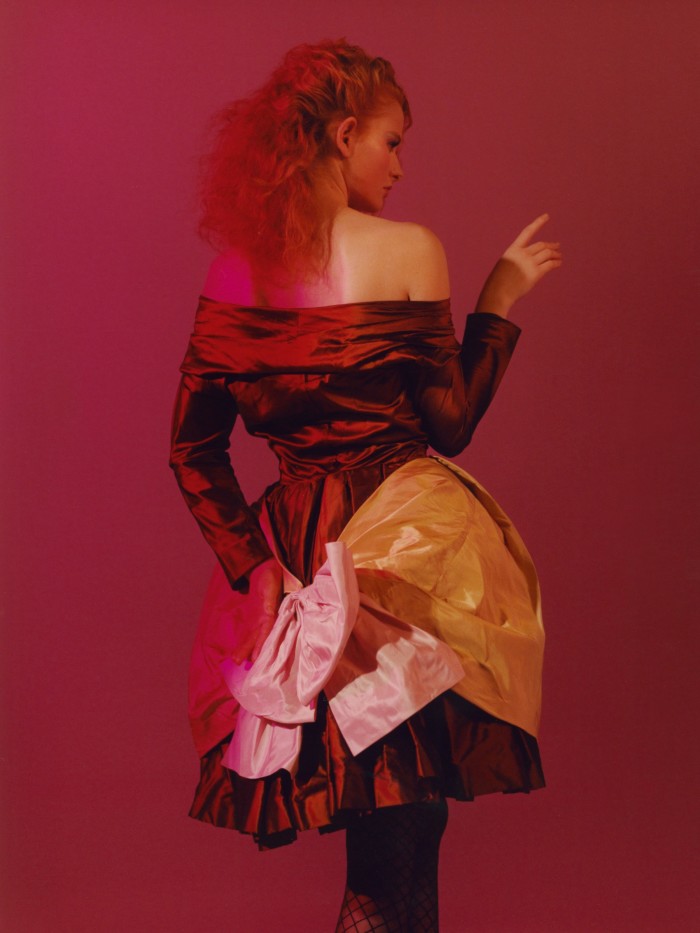
They all paled, though, next to the real deal. After retiring from fashion following the bankruptcy of his company in 2009 and focusing on work in theatre and opera, Monsieur Lacroix returned from a 10-year hiatus to collaborate with Belgian designer Dries Van Noten. The latter described the collection as being about the joy of dressing up, which is what Lacroix has always been all about. It was, pretty much, the high point of the spring 2020 collections – and certainly the only thing that could feasibly eclipse Jennifer Lopez “almost” wearing a green chiffon dress on the Versace catwalk.
Lacroix has always been influential: in the ’80s, he defined the era’s flashy, splashy, look-at-me style. When he began his fashion career at Patou in 1981, Lacroix ignored the house’s heyday of the ’20s (when Patou was a competitor to Chanel) and seemed to take inspiration from its signature perfume. The name, conveniently, was Joy and its formula, requiring 10,000 jasmine flowers and 500 roses, was reputed – retailing at $800 per ounce – to be the most expensive in the world. So were Lacroix’s clothes, which were lavish and loud, and a little ludicrous – as a mid-thigh ballgown in a riot of chintz and with a bustle in front can be. The signifiers of Lacroix’s style are, paradoxically, broadly roaming yet incredibly specific. His clothes were physical collages, colliding 18th-century corsets and belle-époque bustles with ’40s couture and ’70s glam, slinging Byzantine jewellery over the lot, maybe perching it on a Louis XIV heel and tying it up with a ribbon. They were widely and wildly copied by his contemporaries, from haute couture to high street. Lacroix invented the pouf or puffball, conflating two historic silhouettes – the petticoated layers of ’50s couture and the thigh‑high mini-skirt – with the more outré versions tucked up at the back, maybe with a silk cabbage rose. The pouf was, incidentally, a name given to the ribbon-bedecked, sky-high hairstyles fancifully sported by Marie Antoinette’s court and powdered with flour during the riots over grain shortages during the Ancien Régime. Little did Lacroix realise he was headed the same way.
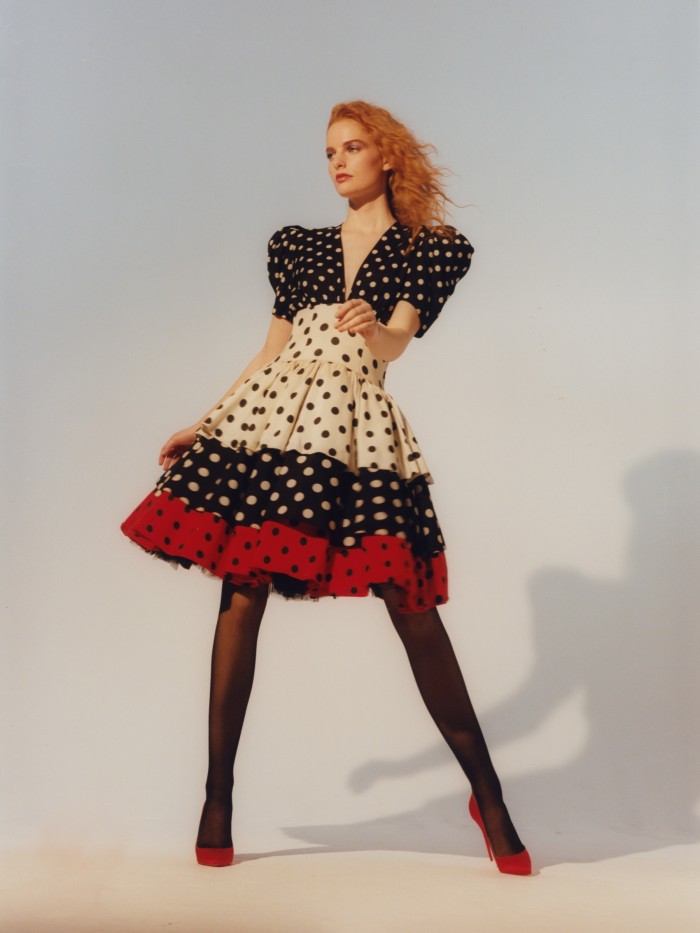
Heady – pardon the pun – was the term for the atmosphere in 1987, when Lacroix’s own label launched with the bold backing of $8m from Financière Agache, the holding company of Groupe Arnault (founded by Bernard Arnault), which still owns 95 per cent of Christian Dior. To many, the establishment of Lacroix, 40 years after the debut of Dior’s sensational New Look, was another echo of history, like his petticoats and corsets. A new dauphin, a saviour of fashion. When Lacroix showed his debut couture show in July 1987, comparison was irresistible. “Like Christian Dior 40 years ago, he has revived a failing institution, the haute couture or made-to-order branch of French fashion,” enthused Bernadine Morris in the normally sedate New York Times.
It sounds hyperbolic, but in a sense, Lacroix did revive couture. His work ignited interest in the then loss leader, where clothes were manufactured by hand for a cadre of clients who were fervent devotees but few in number. Lacroix pulled in new clients: Madonna was among the first. The very first, he tells me, was the publicist Pia de Brantes, for whom he made a wedding dress; the second, her bulldog, for which he made a taffeta cape. He dressed Hollywood in couture before that was a thing – Bette Midler and Faye Dunaway wore Lacroix, as did the wives of M&A magnates and corporate raiders: Gayfryd Steinberg, wife of Saul; Blaine Trump, wife of Robert. Bret Easton Ellis described a character in American Psycho, his searing satire of yuppie culture, as looking like “a big black ant in an original Christian Lacroix”. Lacroix’s style became synonymous in gossip columns with the wackadoodle looks of Princess Gloria von Thurn und Taxis – formerly known as Princess TNT, the Dynamite Socialite. Her daughter Elisabeth von Thurn und Taxis, a contributing editor to American Vogue, wears her mother’s Lacroix hand-me-downs today.
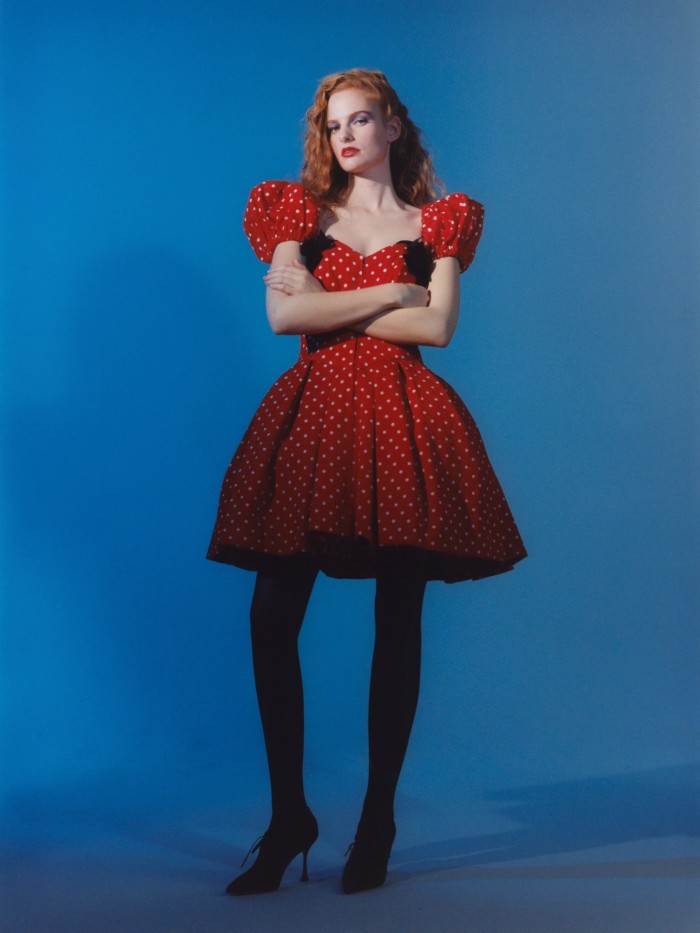
Creatively, Lacroix was also dynamite – and there remains a strong auction market for his archival couture, as evinced by Princess von Thurn und Taxis and fellow neo-nouvelle society figures, such as Lauren Santo Domingo and Giovanna Battaglia Engelbert, wearing the most Lacroix of Lacroix-isms to high-profile events. But Lacroix was unquestionably a commercial disaster. In 22 years, the house never turned a profit. Its much-fêted debut perfume, C’est la Vie, was launched in 1992. It stank, in every sense of the word, and sank. “It was disgusting,” said Lacroix. And bar a short-lived line launched just months after his debut and dubbed Luxe, due to its high quality and stratospheric prices, Lacroix ready-to-wear refused to capture the magic of his haute couture. He was, perhaps, destined to fail: the market conditions that created Lacroix vanished precisely on 19 October 1987, when the Dow Jones plummeted 22.6 per cent, the largest one-day drop in history, plunging the world into recession. Suddenly, Lacroix’s bustles and bows didn’t seem funny, or fashionable, any more. The previously deifying New York Times ran an article in April 1988 asking, “What would you rather have? A Christian Lacroix pouf or…” The options, for the same price – around $15,000, the Times posited – were a down payment on an apartment, a car, a 19-day first-class cruise on the QE2, or 110 shares in IBM. The ready-to-wear failed to recoup the investment. Lacroix was Bernard Arnault’s first major gamble; it went awry. Today, the house of Lacroix continues in name alone, producing soft furnishings and decor products, with a healthy $180m turnover.
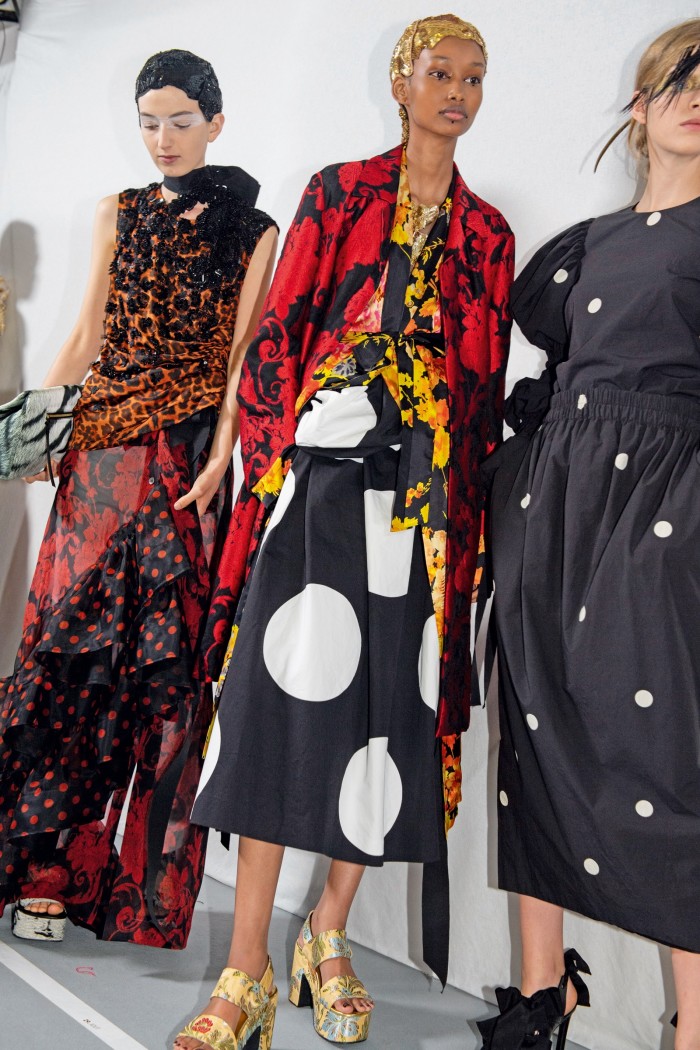
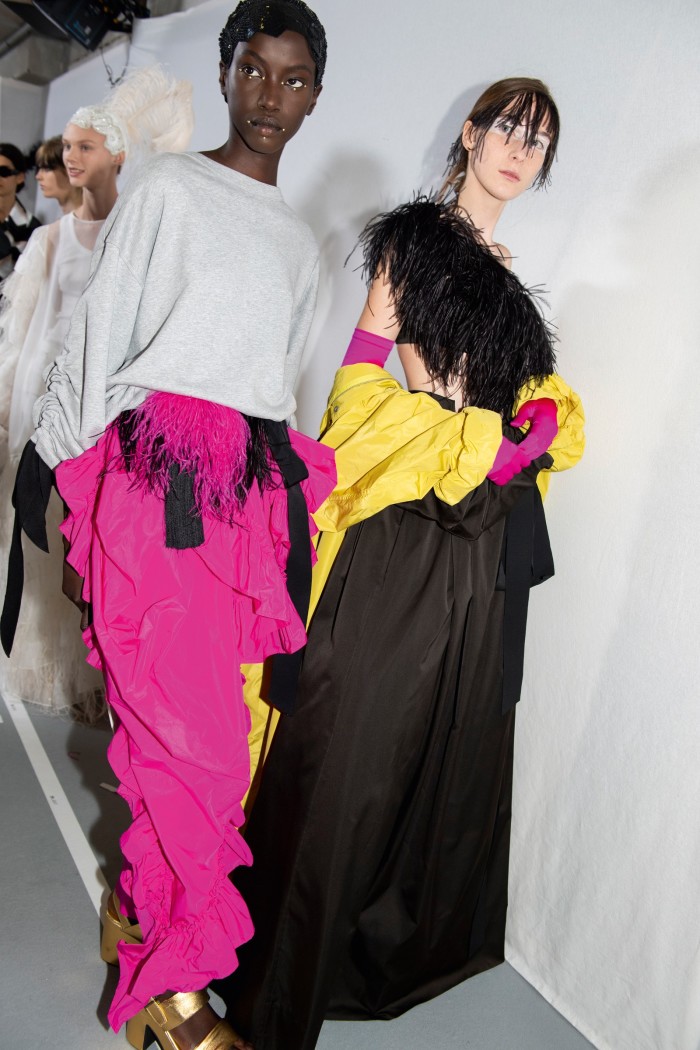
So why is Lacroix back right now? Besides the cyclical nature of fashion, which decrees that minimalism is followed by maximalism, restraint by excess, what is it about right now that makes Lacroix’s looks seem joyous and in sync, rather than ostentatious and out of touch? Maybe it’s to do with the socioeconomic mores of the times. The markets are soaring – all-time stock highs have been hit during January, pushing the S&P 500 up three per cent, after 2019 rises of 30 per cent, and fears of recession seem to be on the wane. Confidence is booming – the S&P 500 value hasn’t been so high since 2002, and the bull market reflects trends from the ’80s as readily as these clothes do. It isn’t just in fashion, either. There was fervour in January over the Sotheby’s auction of the effects of the late Mario Buatta – the “Prince of Chintz”, who decorated for both the Reagans and the New York beneficiaries of their Reaganomics, tufting their satins, swagging their drapes and nailing up tassels and an oil painting of a spaniel on anything that stayed still long enough. Sales totalled $7.6m – more than 2.5 times the already-high auction estimate. And of course, there’s Donald Trump – a reflection of Reagan not only in his economic conservatism and celebrity prior to office, but of the ’80s as a whole. Loud, brash, uncompromising. Like the markets, bullish. Interestingly, the big story from the autumn/winter 2020 menswear collections, shown in January, was the pre-eminence of the suit, tossed about as a pejorative term for anti-creative establishment types and largely absent from catwalks for several years. Next to their Lacroix-ish female counterparts, it’s like 1987 all over again.
Except it’s not. Lacroix clothes are paradoxical – wild but conservative, young yet old, old yet new. If in the ’80s his styles polarised the haves and the have-nots – similar to the attire of Marie Antoinette and her cohorts, or indeed those able to afford the lavish meterage of Dior’s New Look in ration-starved Paris – today, it’s more democratic. Lacroix-influenced styles will be worn by society matrons, sure. His aesthetic has always been beloved by them – a client even offered to bail out Lacroix when it crashed in 2009. But they will also be worn by the young – women, men and drag queens in between – who love Lacroix’s excessive foibles, his sense of fun and exaggeration.
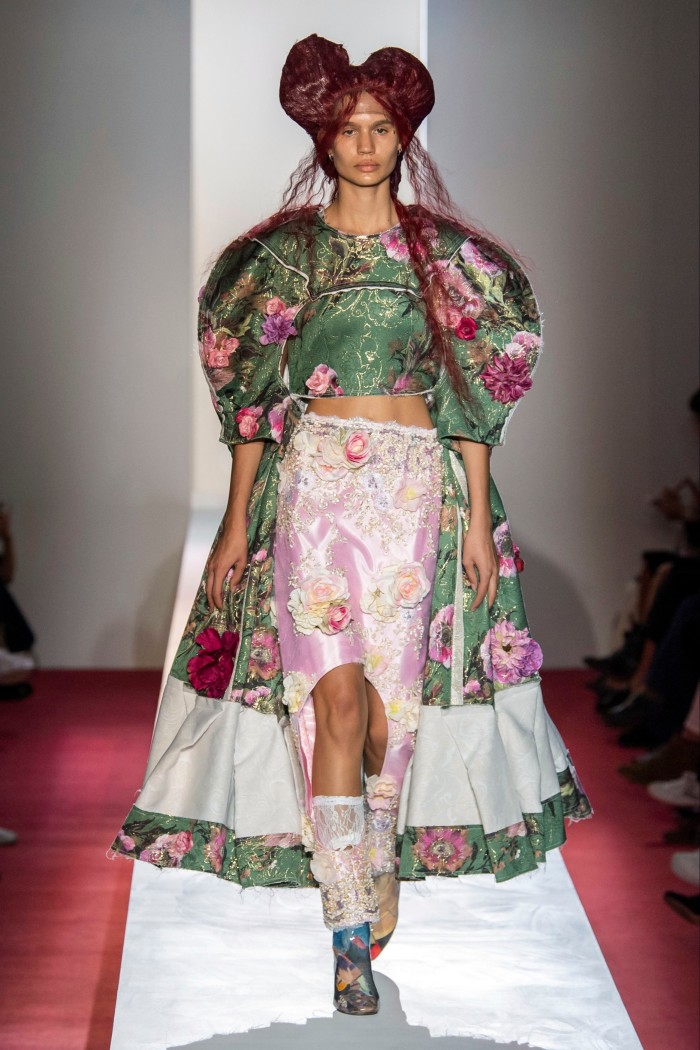
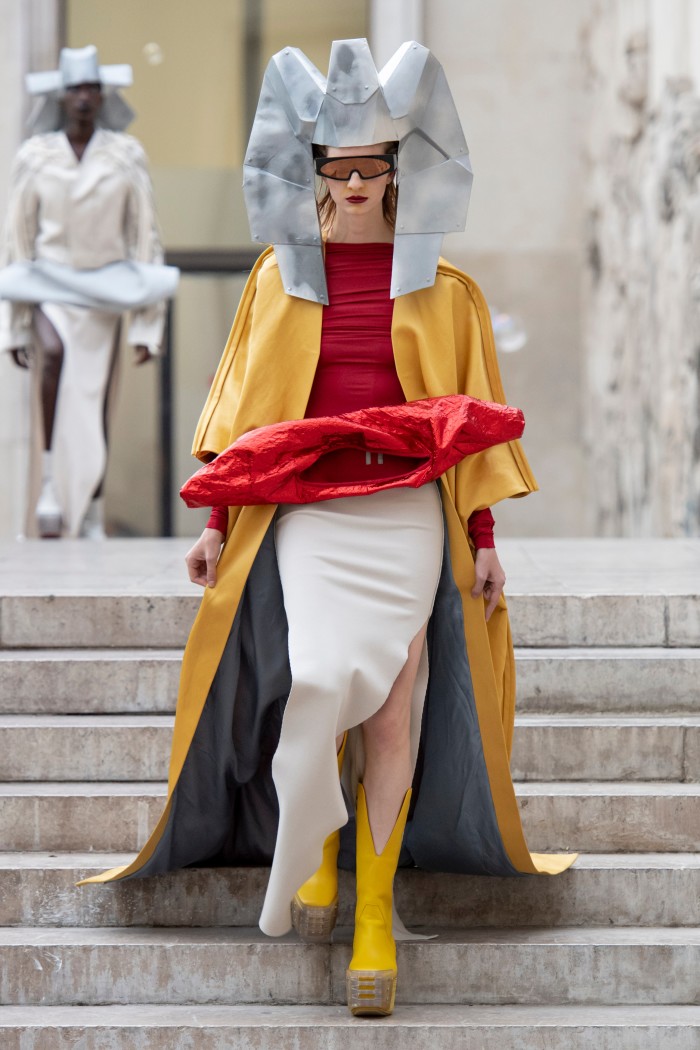
That is what draws me to Lacroix. I collect Lacroix’s clothes – only the haute couture that’s packed with Lacroix-isms. Lacroix’s eye was always sharp and sure, but couture is the one place where purse strings never seemed to impede his rambunctious creativity. I have outfits from his days at Patou: a 1985 tobacco-yellow taffeta coat called Coup de Théâtre, splodged with gargantuan velvet bows, worn over a minidress with a fox-dipped hem; a Spanish-like flurry of tiered polkadots and petticoat, shown to a soundtrack of Josephine Baker songs in January 1987. Lacroix resigned the next day, he told me; the house of Lacroix was subsequently sued by Patou for $14m for unfair competition – not an auspicious start. That froufrou flamenco number was one of his favourites – he named it Retenez-moi (Hold me back). In retrospect, the collection was filled with puns alluding to his imminent departure – one outfit was even called Adieu. I have a laughably short, bubbly cloqué dress from that short-lived Luxe line from spring 1988. And I have two from his first own-label couture line, furiously fought over by customers and department stores, with aprons of taffeta and fichus worn à l’Arlésienne, like 19th-century portraits. Look 27, a cocktail dress, sat in the window of Bloomingdale’s, Lexington Avenue, for just a week after Black Monday – a single outfit then offered exclusively for sale for $15,000. But it’s not about money. I love them all because he’s a fashion hero, and because they represent a moment, a man’s passion, a dream. A joy that refuses to die.
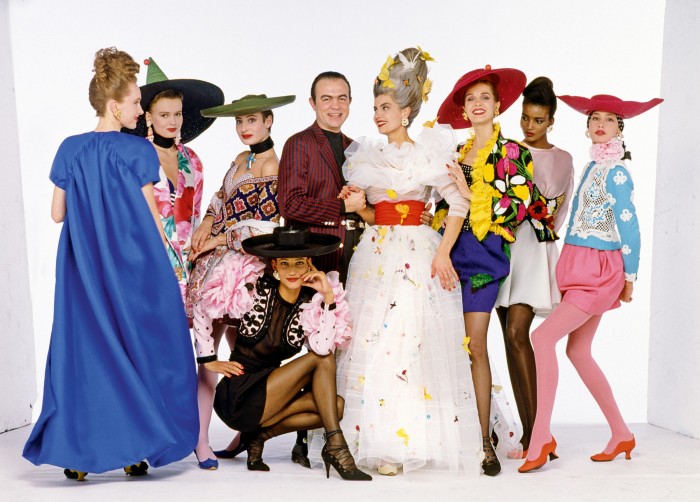
Backstage at Dries Van Noten’s masterful show, after both designers had taken a bow to a throng of well-wishers, I found Monsieur Lacroix. He was beaming. This was his last hurrah to fashion, a swift return for another adieu. He has no intention of starting a couture line again, and is happy to continue his work designing costumes and scenography for theatre and opera. “Retenez-moi? Non, merci.” I kissed Lacroix on both cheeks, as you do, and he smiled widely and laughed. He grabbed me, pulled me in, and whispered in my ear: “Better than J.Lo, non?”
“Oui, Christian. Bien sûr.”
Comments